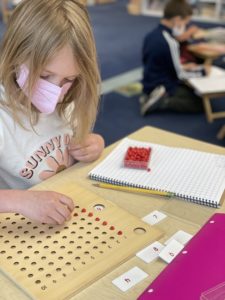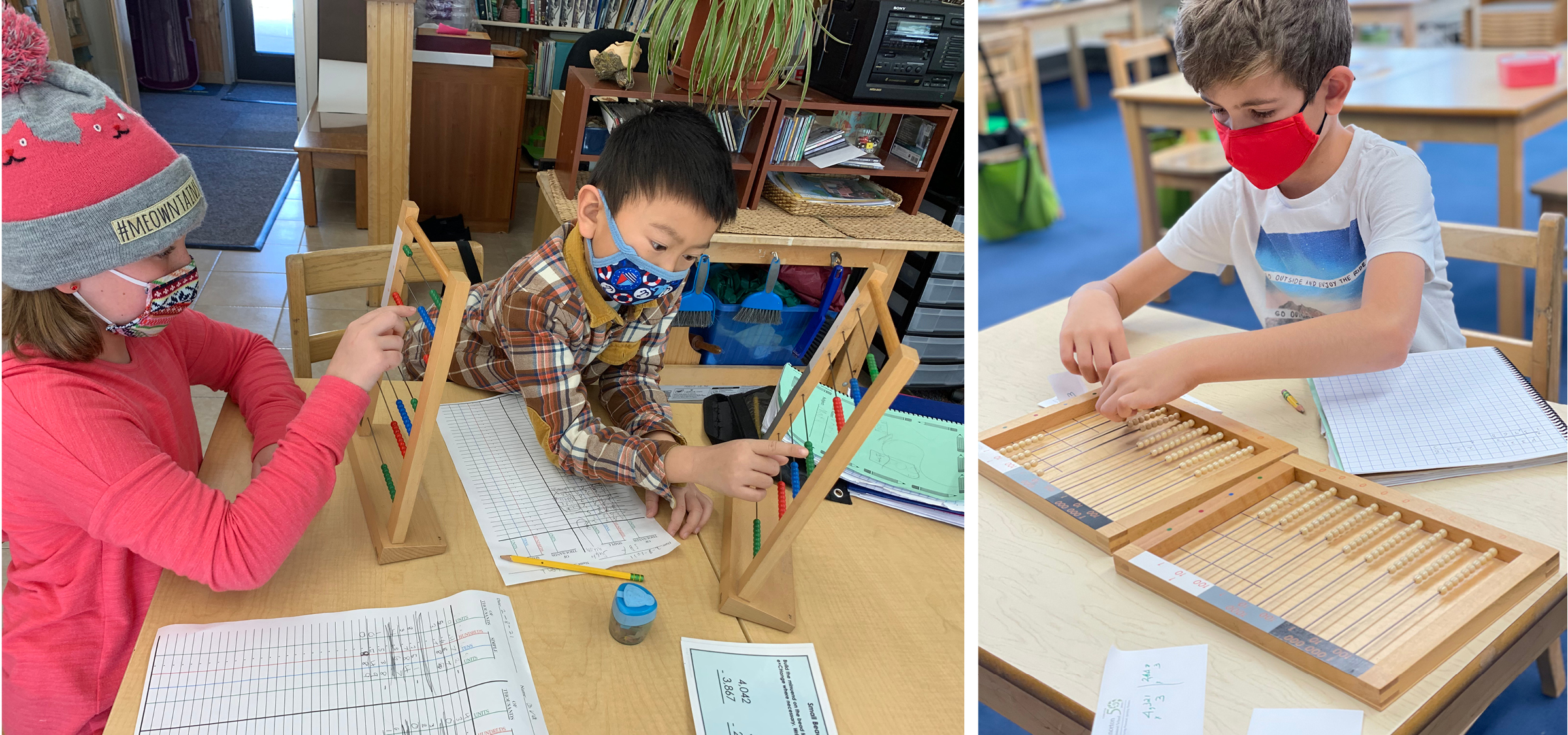
The Value of Mistakes in Mathematics
by Aish Saminathan, Lower Elementary Teacher
 A day before the winter break years ago, during my internship period as a Montessori teacher, a third-grader came up to me to confirm her answer for a division problem. Sitting beside a rug on which my then five-month-old was practicing her mini push-ups, the nine-year-old had spent over two hours meticulously setting up a Montessori material called ‘Racks and Tubes’ and arriving at a quotient for the problem with a six-digit dividend and a four-digit divisor. “Is this right?” she asked.
A day before the winter break years ago, during my internship period as a Montessori teacher, a third-grader came up to me to confirm her answer for a division problem. Sitting beside a rug on which my then five-month-old was practicing her mini push-ups, the nine-year-old had spent over two hours meticulously setting up a Montessori material called ‘Racks and Tubes’ and arriving at a quotient for the problem with a six-digit dividend and a four-digit divisor. “Is this right?” she asked.
I looked at her elaborate set up of the material – an orderly line of test tubes and tiny cups filled with beads, representing different place values with designated colors. I noticed a few missing beads in the hundred-thousandths cup. To be sure, I calculated the problem on my notepad only to find that the hundred-thousandth place was off by a few thousand. Under her curious gaze, I was facing a conundrum that would continue to resurface during many such interactions: to transform the moment into a teachable one and short-circuit the child’s pride of completing a problem or to quell my devotion to correctness and calibrate her capacity to embrace mistakes.
Mistakes can be costly. In 1999, a climate orbiter of NASA crashed into the surface of Mars due to an oversight in converting the units from English to metric, costing the country nearly half a billion dollars. Mistakes, however, have also led to priceless discoveries – from the planet Uranus to the decadent chocolate chip cookies.
More importantly, mistakes make learning possible. Every time a child makes a mistake, even before she is aware of making that error, her action sets off an impressive chain reaction in her brain’s neural network. Error neurons, as neuroscientists call them, begin to fire in a millisecond, followed by a dizzying number of firing synapses that light up the brain to make newer connections, thus making her cognitively smarter.
Yet, the fear of making mistakes has driven our educational system to create a conventional standard for mathematics that presents myriad concepts into siloed chapters and punctuates them with assessments and timed tests, all designed with military precision. Assessments, in essence, are helpful. They share a window into students’ interests and abilities, so a teacher can fine-tune her goals for the students periodically. A meta-analysis has shown that tests could sometimes help students with better retention of concepts for a period of time. The most commonly adopted testing methodology can, however, be unforgiving towards mistakes.
Conventional testing – be it standardized testing or an individual one adopted by a school district – is usually replete with questions that emphasize the procedures and drilled-in algorithms. Ironically, the goal of such testing, which is to gain an objective assessment of every child’s understanding and capability, is more often compromised. Under pressure, the reasoning part of our brain takes a backseat. An MRI study on seven-to-nine-year-old children showed that math anxiety, commonly induced by tests, increased activity in the amygdala region associated with negative emotions and decreased activity in the posterior parietal and dorsolateral prefrontal cortex area, which are associated with mathematical reasoning.
Practice, in the case of testing, does not lead to better performance. In a longitudinal study conducted in England, students, between 13 and 16 years, were not given tests but instead worked on open-ended projects for three years. Despite zero familiarity with testing, the students who took standardized exams at the end of the third year scored significantly higher than the students who spent three years working through questions similar to the national exam questions.
The study was completed in 1998. Yet, timed tests for mathematics continue to feature in math curriculums and students’ anxiety associated with the test continues to hamper their learning.
At a time when a dizzying array of math assessments are relentlessly bombarding us, it is important for both educators and parents to subject them to the litmus test of a solitary question – “Does this curriculum/assessment allow room for open-ended discussions, elaborate visual work, slow thinking and making mistakes?”
“Serious use of the mind takes time,” educator Ted Sizer once said. “If you have really high intellectual standards for kids, the curriculum overloaded with stuff has to give way.”
When Maria Montessori developed math materials, she set students to these high intellectual standards. She believed that children are inherently drawn to organize, compare, classify and recognize patterns and relationships. Disparate concepts are strung together in Montessori’s elementary curriculum, aptly named spiral curriculum, by fusing numeracy with cultural subjects (children working on timelines and understanding the chronology of eons), with art (works on symmetry, geometrical shapes) and with language (grammar symbols for noun families are three types of triangles and the same work called ‘detective triangles’ is used to draw parallels between geometry and parts of speech).
Control of errors is built into Montessori materials for the children to recognize mistakes as part of the learning process. As an educator who saw math not as a job skill but as a creative act, Dr. Montessori envisioned an education for a new world where educators will cease to see children as mere recipients of didactic largesse and instead as change agents of peace and social justice. When put to work, her philosophy engenders active thinking, grappling with hard work and embracing mistakes.
Back in the classroom, I looked up at the girl. “What do you think?” I asked. “I know the answer is wrong,” she said, sheepishly. “I accidentally dropped a few beads.” “Well,” I said, “I’m checking off the work but let us find those beads before she [my infant] does.” We laughed and got on to our knees for yet another exploration for the day.
 References:
References:
- https://www.wired.com/2010/11/1110mars-climate-observer-report/
- https://earthsky.org/space/this-date-in-science-uranus-discovered-completely-by-accident
- https://www.epicurious.com/archive/blogs/editor/2014/07/things-you-didnt-know-about-chocolate-chip-cookies.html
- https://www.cell.com/neuron/fulltext/S0896-6273(18)31007-9?_returnURL=https%3A%2F%2Flinkinghub.elsevier.com%2Fretrieve%2Fpii%2FS0896627318310079%3Fshowall%3Dtrue
- https://www.semanticscholar.org/paper/Rethinking-the-Use-of-Tests%3A-A-Meta-Analysis-of-Adesope-Trevisan/2a2756b75e3ab15e6bda29203f9be32b90772e60?p2df
- https://www.ncbi.nlm.nih.gov/pmc/articles/PMC3462591/
- https://mathed.net/wiki/Boaler_(1998)
- http://essentialschools.org/horace-issues/less-is-more-the-secret-of-being-essential/